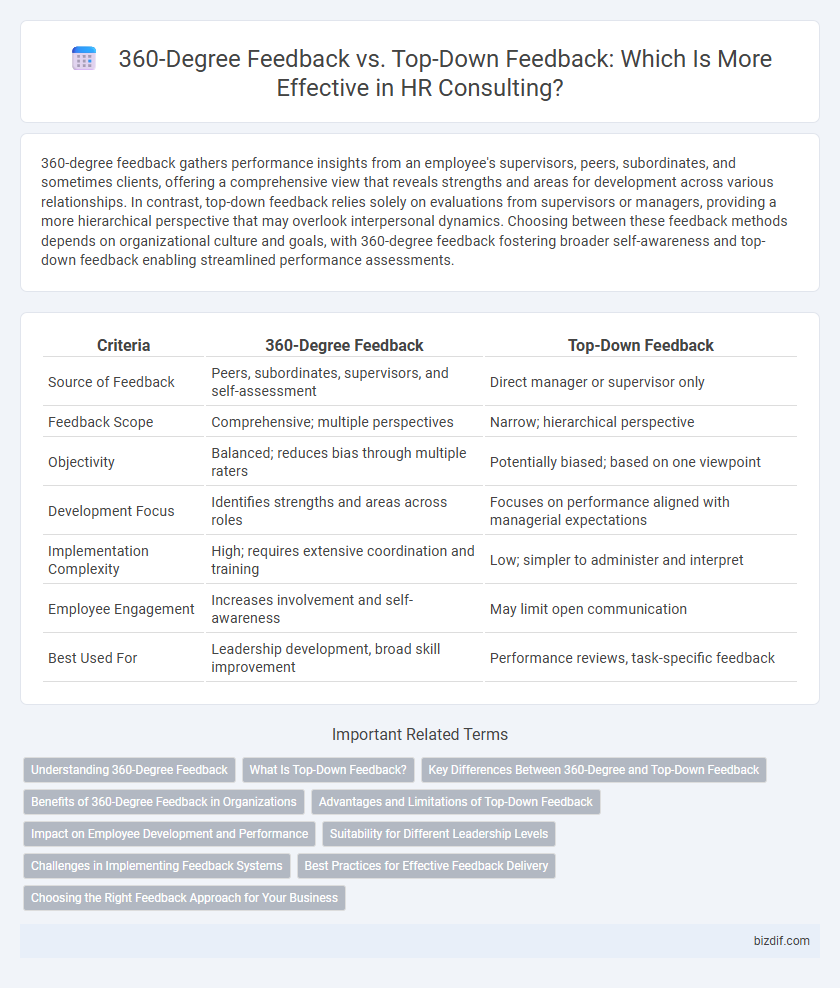360-degree feedback gathers performance insights from an employee's supervisors, peers, subordinates, and sometimes clients, offering a comprehensive view that reveals strengths and areas for development across various relationships. In contrast, top-down feedback relies solely on evaluations from supervisors or managers, providing a more hierarchical perspective that may overlook interpersonal dynamics. Choosing between these feedback methods depends on organizational culture and goals, with 360-degree feedback fostering broader self-awareness and top-down feedback enabling streamlined performance assessments.
Table of Comparison
| Criteria | 360-Degree Feedback | Top-Down Feedback |
|---|---|---|
| Source of Feedback | Peers, subordinates, supervisors, and self-assessment | Direct manager or supervisor only |
| Feedback Scope | Comprehensive; multiple perspectives | Narrow; hierarchical perspective |
| Objectivity | Balanced; reduces bias through multiple raters | Potentially biased; based on one viewpoint |
| Development Focus | Identifies strengths and areas across roles | Focuses on performance aligned with managerial expectations |
| Implementation Complexity | High; requires extensive coordination and training | Low; simpler to administer and interpret |
| Employee Engagement | Increases involvement and self-awareness | May limit open communication |
| Best Used For | Leadership development, broad skill improvement | Performance reviews, task-specific feedback |
Understanding 360-Degree Feedback
360-degree feedback collects performance insights from multiple sources including peers, subordinates, supervisors, and self-assessments, providing a comprehensive view of an employee's strengths and development areas. This method improves self-awareness by highlighting differing perceptions across organizational levels and promotes a more balanced evaluation compared to top-down feedback, which relies solely on managerial judgment. Implementing 360-degree feedback enhances employee engagement and supports targeted development plans aligned with organizational goals.
What Is Top-Down Feedback?
Top-down feedback is a performance evaluation method where supervisors assess their employees' work, providing insights primarily from management to staff. This approach emphasizes hierarchical communication, often highlighting employee strengths, areas for improvement, and alignment with organizational goals. Unlike 360-degree feedback, top-down feedback lacks input from peers or subordinates, concentrating exclusively on top-tier perspectives.
Key Differences Between 360-Degree and Top-Down Feedback
360-degree feedback involves collecting performance evaluations from multiple sources, including peers, subordinates, and supervisors, offering a comprehensive view of an employee's skills and behaviors. Top-down feedback is limited to input from supervisors alone, providing a more hierarchical perspective focused on managerial expectations and goals. The key difference lies in the breadth of input, with 360-degree feedback promoting multi-faceted development insights, while top-down feedback emphasizes authoritative performance assessment.
Benefits of 360-Degree Feedback in Organizations
360-degree feedback enhances organizational development by providing employees with comprehensive insights from peers, subordinates, and supervisors, fostering self-awareness and balanced performance improvement. This holistic approach supports better leadership development and promotes a culture of open communication, driving employee engagement and reducing bias commonly found in top-down feedback. Organizations leveraging 360-degree feedback often experience improved teamwork, higher productivity, and stronger alignment with organizational goals.
Advantages and Limitations of Top-Down Feedback
Top-down feedback offers clear hierarchical insights by channeling evaluations from supervisors to subordinates, ensuring alignment with organizational goals and streamlined decision-making. This method promotes accountability and simplifies performance assessment but may suffer from bias and limited perspectives, potentially neglecting employee development areas evident through peer or self-assessments. Organizations relying solely on top-down feedback risk overlooking critical interpersonal dynamics and comprehensive performance metrics available in 360-degree feedback systems.
Impact on Employee Development and Performance
360-degree feedback offers comprehensive insights by collecting evaluations from peers, subordinates, and supervisors, fostering well-rounded employee development and enhancing self-awareness. Top-down feedback provides clear directives from managers, streamlining performance expectations but often limiting the perspective required for holistic growth. Combining both approaches can maximize employee engagement, skill enhancement, and overall organizational performance.
Suitability for Different Leadership Levels
360-degree feedback provides comprehensive insights by gathering evaluations from peers, subordinates, and supervisors, making it highly suitable for middle and senior leadership development. Top-down feedback, primarily delivered from supervisors to employees, is effective for frontline managers and entry-level leaders who require clear, directive guidance. Selecting the appropriate feedback method enhances leadership growth by aligning feedback complexity with the leader's experience and role within the organizational hierarchy.
Challenges in Implementing Feedback Systems
Implementing 360-degree feedback systems in HR consulting often faces challenges such as ensuring anonymity to foster honest responses, managing the increased administrative workload, and addressing potential biases from multiple raters. Top-down feedback, while simpler to administer, can result in limited perspectives and reduced employee engagement due to its unidirectional nature. Both systems require careful design to overcome resistance, maintain confidentiality, and ensure actionable insights for effective performance improvement.
Best Practices for Effective Feedback Delivery
Implementing a 360-degree feedback system enhances employee development by incorporating diverse perspectives from peers, subordinates, and supervisors, promoting comprehensive performance insights. In contrast, top-down feedback provides clear and direct evaluations from management but may lack the multidimensional view necessary for holistic growth. Best practices for effective feedback delivery include ensuring feedback is specific, actionable, and balanced, fostering open communication, and creating a supportive environment that encourages continuous learning and improvement.
Choosing the Right Feedback Approach for Your Business
360-degree feedback offers comprehensive insights by collecting evaluations from peers, subordinates, and supervisors, promoting a well-rounded assessment of employee performance. Top-down feedback provides clear, direct evaluation from supervisors, streamlining decision-making and accountability. Selecting the right approach depends on your company culture, organizational structure, and the specific goals of the feedback process to enhance employee development and business outcomes.
360-Degree Feedback vs Top-Down Feedback Infographic

 bizdif.com
bizdif.com